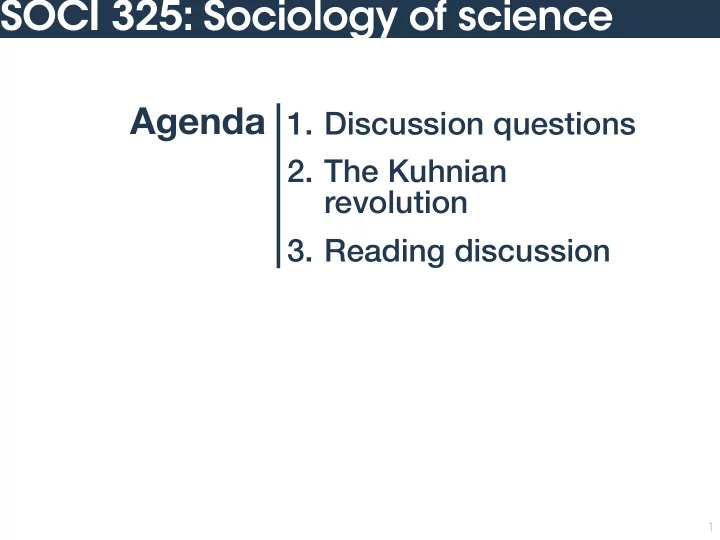

SOCI 325: Sociology of science Agenda 1. Discussion questions 2. The Kuhnian revolution 3. Reading discussion 1
Discussion questions 2
Discussion questions Student question submissions So far: ⦙ Today’s submissions quite good. ⦙ Three submissions are included in today’s questions. Notes: ⦙ You must include a few (2–3) sentences motivating your question. Why do you think the question in important? What kind of discussion do you hope it will spur? ⦙ Please limit your submission to one discussion prompt. Focus on a single, broad concept from the reading(s). ⦙ Submissions are due by 5pm the day before. 3
Discussion questions Example submission Question : Think about the ways that contemporary, mainstream science One (broad) idea, describes variation in human bodies (e.g. genes, BMI, hormone described in a levels, …). Can you think of examples where certain few sentences disadvantaged groups in society are singled out by some of these descriptions? Do any of these scientifically described variations reflect existing cultural biases? Motivation : I have read accounts of di ff erent ways that people from Motivation that marginalized groups experience discrimination that is couched specifies where in scientific terminology (e.g. Benjamin (2019) talking about the question is coming from and race-based discrimination from AI, or news articles about where I hope it women being misdiagnosed by doctors as having weight- may lead. related health problems because of BMI). I think it will be useful to consider how these types of issues are both similar to and di ff erent from the scientific racism Gould discusses. 4
The Kuhnian revolution 5
Kuhnian revolution Thomas Kuhn (1922–1996) ⦙ Physicist by training ⦙ Transitioned to history and philosophy of science after PhD The Structure of Scientific Revolutions ⦙ First published in 1962 ⦙ Coined contemporary usage of the term ‘paradigm’ ⦙ Directly confronted the prevailing (norm-centric) view of science as an institution ⦙ Had a huge impact, arguably spurring its own paradigm shift in the philosophy and sociology of science 6
Kuhnian revolution Why was Kuhn revolutionary? Anti-positivist ⦙ Positivism : observations inform and shape theories. ⦙ In TSSR, Kuhn suggests instead that the theoretical frameworks of a paradigm shape observations and define scientific facts. ⦙ For Kuhn, facts do not exist without a paradigm that can give them meaning. Observation is dependent on theory. Anti-falsificationist ⦙ Falsificationism : theories are disproven by counter- examples. ⦙ Kuhn argues that counter-examples (anomalies) do not normally cause crisis. ⦙ Only during revolutions in paradigm are anomalies employed as justification for new worldviews. 7
Discussion 8
Discussion Small-group discussions: ⦙ If you are not in a group , try to find one with less than 5 before forming a new group ⦙ Choose a new facilitator who will keep the discussion focussed and make sure everyone is able to participate. ⦙ Choose a new secretary who will take notes and summarize the group’s responses for submission. ⦙ Download today’s discussion questions (Microsoft Word format) from the link on the syllabus. Make a copy and upload to MyCourses. https://soci325.netlify.com/discussion_questions/04.02.docx Notes (again): ⦙ Try to respond to (almost) all of the questions. ⦙ Avoid terse, bullet-point style. ⦙ Refer directly to the text. 9
Next class Structural barriers to participation in science Required reading: • van den Brink and Benschop (2012) Gender practices in the construction of academic excellence: Sheep with five legs 10
Recommend
More recommend